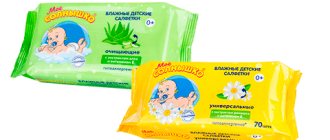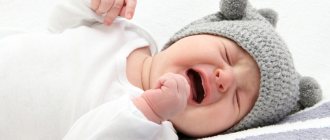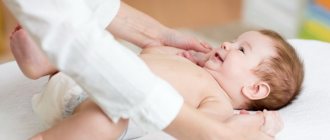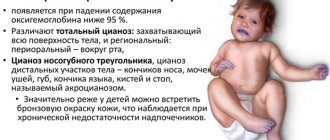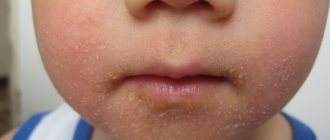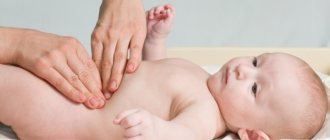Why do babies have enlarged mammary glands? Should I worry and how to determine pathology? Breast enlargement in infants is a fairly common problem. For obvious reasons, this symptom is most often observed in girls.
Despite the fact that such a symptom is not dangerous in most cases, it cannot but worry mothers. Therefore, it is important to understand how breasts are formed and what metabolic processes affect them. While the unborn child is in the womb, he receives a certain amount of sex hormones from her body. They influence the formation of not only the mammary glands, but also the entire reproductive system, both in boys and girls.
Physiology of infants
Breast tissue is very sensitive to hormonal fluctuations. Breast development is primarily influenced by estrogen. The more female sex hormone enters the mammary gland tissue, the larger it grows. All children, regardless of gender, experience slight breast enlargement in the first days of life. It is associated with the release of hormones before childbirth. Over time, the swelling subsides.
As the child develops, the mammary glands become coarser. This process is called physiological mastopathy (it is important to distinguish it from pathology - mastopathy, which also occurs in infants). The child grows and the breasts become larger and denser. Moreover, the process may occur unevenly: on one gland the swelling is visible, on the other – not. This condition does not require treatment and does not cause discomfort to the baby. Normally, swelling stops a month after birth.
Normal child development involves:
- Breast swelling up to a maximum of 3 cm.
- The appearance of slightly colored, often colorless, discharge.
- Swollen nipples.
- Rough nipples and halos.
It is important not to injure the breasts, select the softest clothes and diapers, and do not try to squeeze out the contents of the breast. Otherwise, you can cause an infection and cause the formation of microcracks around the nipple. Bacteria can penetrate through them, and the child will experience significant discomfort. It is necessary to adhere to the rules of hygiene and ensure that the baby does not injure the breast. If you have any concerns about your child’s condition, you should immediately consult a specialist.
If you notice discharge and swelling in the first month, do not worry - this is a physiological process that is not dangerous for the baby. However, it is important to distinguish natural swelling from disease. Fortunately, mastitis and tumors rarely affect infants, but some breast diseases can also occur in children.
Mastopathy in newborn girls and boys
Hormonal crisis in infants is a fairly common problem that many parents face. In this case, physiological mastopathy manifests itself in both newborn girls and infant boys.
It is considered normal and is a natural sign of the baby’s adaptation to new conditions outside his mother’s body. However, this condition can cause severe discomfort to the child, so parents need to know how to help their baby.
Causes and symptoms of mastopathy in children
Often mastopathy appears in children after one year. The child may refuse to eat, be capricious, and have trouble sleeping at night. At an older age, the baby can already explain what is bothering him and complain about chest pain.
Despite the child’s young age, he may develop a cyst or fibrous tumor in the mammary glands. The signs of this disease in children are almost no different from the symptoms in adults.
In adolescents, diffuse mastopathy is most often diagnosed. A large number of small nodules that do not create compactions form in the chest.
But they can also provoke pain that can bother the child.
Mastopathy in children is diagnosed by ultrasound. This type of examination, such as mammography, is not used until a person reaches 30 years of age.
The main symptoms of the disease are:
- severe swelling of the mammary gland;
- pain when touching the chest;
- redness of the skin in the affected area;
- increase in breast size;
- whitish discharge.
Normally, breast enlargement occurs by no more than 2 cm. Discharge from the nipple resembles colostrum.
If mastopathy is natural for newborns, then at the age of 3 years or more it ceases to be a physiological phenomenon and should be examined to prescribe treatment. Therapy is necessary, since the pathology does not disappear on its own and can provoke the development of severe complications.
The main causes of mastopathy in infants are:
- hormonal changes due to adaptation to a new environment;
- the influence of maternal hormones obtained with milk.
In older children and adolescents, mastopathy can develop due to:
- pathologies of the endocrine glands;
- taking certain medications;
- liver diseases;
- stress.
In this case, contacting a doctor is mandatory.
Treatment of mastopathy
Since mastopathy detected in newborns is not considered a pathology, it does not require specific treatment. But if the symptoms are too severe, for example, there is significant discharge from the mammary glands, then outside help is still needed:
- The mammary glands are carefully treated with a weak solution of potassium permanganate. Fucorcin can be used instead.
- Parents need to ensure that clothes do not rub the child's chest. Tight swaddling of the chest should also be avoided.
- Applying and regularly replacing a dry and warm, always sterile, dressing on the mammary glands.
Under no circumstances should you use the following methods of treating mastopathy in young children:
- Warming up. Despite the fact that mastopathy is not accompanied by an inflammatory process, it is not recommended to use heating as a treatment method, although a slightly warm bandage can be applied. If you specifically try to heat the affected area, aseptic inflammation or non-infectious mastitis may occur in the mammary gland. This pathology often causes the development of pathogenic microorganisms, in particular staphylococci. Such complications require treatment with antibiotics and sometimes surgery to remove the pus.
- It is forbidden to try to squeeze out the contents of the mammary glands at home, as well as use other methods to speed up the disappearance of unpleasant symptoms.
- Massaging the breasts of a newborn with mastopathy is also not recommended. In infants, the skin of the nipples is very delicate and sensitive. Massage can cause microcracks, which often become infected with bacteria. And this is the main reason for the development of purulent mastitis in children.
- Using folk remedies - various ointments, decoctions and compresses - without prior consultation with a doctor. This is strictly prohibited. Infants are at high risk of developing allergies not only to medications, but also to herbs and other components. Such products can only be used after consultation with the pediatrician. They will help heal microcracks on the chest and nipples.
Compliance with these rules will help avoid breast infection and the development of purulent mastitis in newborns. It should also be remembered that the long-term (more than 1-2 months) presence of symptoms is grounds for contacting a doctor.
Source:
Physiological and hormonal mastopathy: in newborn girls and boys, children and adolescents
Mastopathy is a pathological condition accompanied by the proliferation of glandular breast tissue. The disease can be diagnosed not only in women of reproductive age, but also in men and even newborn children. The provoking factors are the same everywhere - hormonal imbalance and the penetration of pathogenic microorganisms into the body.
Symptoms and types of mastopathy in children
The first benign changes in the mammary glands occur soon after the child is born. In medicine, this phenomenon is called “physiological mastopathy” or “neonatal mastopathy”. According to statistics, more than 50% of young parents encounter this phenomenon. The definition of “physiological” implies the natural course of events and the baby’s adaptation to new conditions.
During development in the womb, the child receives a large concentration of female hormones, thanks to which full development occurs.
Soon after birth, this process stops, which encourages the body to produce everything on its own. The first symptoms of a hormonal crisis usually appear on days 3-5 of life.
The peak occurs on days 7-11, when the newborn’s body has not yet fully adapted and the estrogen concentration is minimal.
Clinical picture of physiological mastopathy:
- Swelling of the mammary glands, especially the nipples and parapapillary area. A swelling size not exceeding 30 mm in diameter is considered within normal limits.
- Various skin rashes are possible, but rare.
- Slight redness of the skin around the nipple, no significant pain is noted.
- A concomitant symptom may be slight swelling of the genital organs.
- There may be slight discharge of secretions from the nipples. It is important not to squeeze the mammary glands yourself, as this can cause infection of healthy tissue and injury.
When several symptoms appear simultaneously, the newborn becomes capricious and restless. Gradually, the disease goes away on its own after 3-5 weeks.
Mastopathy in children after one year is accompanied by the following clinical picture:
- Swelling of one mammary gland, redness of the skin and swelling.
- Bursting sensation, as if there is a foreign object under the skin.
- Enlargement of the mammary gland.
- Discharge from the nipple of a liquid and sticky secretion, usually colorless or yellow in color.
- Discomfort or pain when touched, burning and itching.
It is necessary to immediately show the child to a specialist.
Diagnosis and causes of development of childhood mastopathy
To confirm a hormonal imbalance, the child will need to be examined by highly specialized specialists and undergo a series of laboratory and instrumental examinations. A mammologist or gynecologist or endocrinologist can help in this matter. A laboratory blood test for hormone levels is required, as well as an ultrasound examination of the mammary glands (ultrasound).
If there is a suspicion of infectious inflammation, a surgeon should examine the child. In most cases, the inflammatory process in the chest develops against the background of Staphylococcus aureus entering the body. It can penetrate through the excretory ducts in the mammary glands or through the damaged upper layer of the epidermis if it is not properly cared for. These factors provoke the development of mastopathy.
In severe cases of infection, the development of phlegmon is possible - a severe pathological condition accompanied by extensive purulent inflammation, which has no clear boundaries.
This condition is especially dangerous for young girls, since the disease can lead to irreversible structural changes in the mammary glands. Complications include underdeveloped breasts at an older age, as well as blockage of the excretory ducts.
This form of mastopathy requires complex treatment, including surgery.
Causes of physiological mastopathy in newborns
Ambient temperature influences the development of physiological mastopathy in a newborn
The development of the disease in newborns indicates the course of a hormonal or sexual crisis. This pathological condition develops as a result of the penetration of a large concentration of the hormone estrogen from the mother’s body into the genitals or mammary glands of the child.
According to statistics, mastopathy develops more often in girls, due to the removal of maternal hormones. Also, a list of negative phenomena from the external environment leads to the appearance of the physiological form of the disease.
- Constant contact of the child with external stimuli, as a result of which all the baby’s senses are involved: visual, auditory, tactile and taste buds.
- During birth, the baby is faced with such a natural phenomenon as gravity. She was absent during intrauterine development.
- Ambient air temperature. The indicators are significantly lower in comparison with the temperature environment in a woman’s body. For example, it was stable 37 degrees, but it became no more than 25. For a child, this is a sharp change and not every body is able to adapt to this in a limited period of time.
The physiological form of mastopathy in newborns rarely becomes pathological.
Treatment and prevention
In newborns and children under one year of age, in most cases, diagnosed mastopathy does not require treatment unless its course causes pain. In adolescence and adults, it is mandatory to undergo a therapeutic course, especially for people with a predisposition to developing cancer.
Treatment of mastopathy in children under one year of age
If therapy does not produce results, surgical intervention is necessary
In a child under 9 months, the development of pathology is considered a consequence of hormonal imbalance. To relieve symptoms, the doctor can develop a preventive treatment course, including mild medications and observation.
In severe cases of the disease, hormone replacement therapy is required. If it does not bring positive dynamics, mandatory surgical intervention is required.
It is forbidden to self-medicate, especially with taking hormonal drugs, since hormonal imbalance can unpredictably affect the condition of a still fragile body, complications can be irreversible.
It is prohibited to copy standard treatment protocols, since each organism is individual and the genetic level of hormones is different for everyone.
Treatment of the disease in adolescent children
In teenage girls, breast mastopathy develops in a diffuse form.
This pathological condition is accompanied by the formation of a large number of small nodules, which are almost impossible to detect upon palpation.
The total mass of tissue in the chest increases, provided that the specific mass of breast tissue remains unchanged - this state of affairs aggravates the functioning of the endocrine and thyroid glands, which leads to hormonal imbalance.
Treatment includes the following steps:
- Examination. As a rule, making a diagnosis requires the opinion of three specialized doctors - a surgeon, an endocrinologist and a mammologist. Everyone evaluates the condition and proposes an effective treatment regimen. To make a diagnosis, blood tests for thyroid hormones, growth hormone and sex hormones, as well as an ultrasound, are prescribed.
- Based on the results obtained, taking into account the individual characteristics of the child’s body, a therapeutic course is drawn up. Physiotherapy sessions are sometimes added to traditional treatment, for example, UV radiation, vibration therapy, electrophoresis.
Source: https://sakh-hospital.su/gipotalamus/mastopatiya-u-novorozhdennyh-devochek-i-malchikov.html
Causes and prerequisites for breast diseases
There are several main reasons for the development of breast pathologies in a child:
- Various disorders in the functioning of the brain. Due to infectious diseases, trauma, radiation, congenital brain injuries and diseases. If the areas of the pituitary gland or hypothalamus are damaged, the natural hormonal balance is disrupted. Hormones begin to be released that children should not normally have. These hormones are called gonadotropins and lead to the growth of breast tissue.
- Hypothyroidism and other diseases of the endocrine system that lead to disruption of the thyroid gland.
- Functional testicular failure in boys. This condition is called prepubertal hypogonadism. Due to poor functioning of the testicles, the amount of testosterone decreases and pathological breast growth begins.
- Ovarian cysts in girls.
- Ovarian tumors in girls.
- Some diseases of the adrenal glands, more often congenital. For example, adrenal hyperplasia can manifest as enlarged mammary glands in girls.
- Pituitary tumor – prolactinoma. This neoplasm produces the hormone prolactin and at the same time suppresses the normal functioning of the hypothalamic-pituitary system.
- Pinealoma is a tumor of the pineal gland.
- Congenital syndrome of increased production of growth hormone. It can lead not only to the growth of breast tissue, but also to premature sexual development in general.
There are other reasons that are classified as conditionally pathological, since these conditions do not require treatment:
- Obesity. May cause visible breast enlargement. However, this cannot be considered a disease; a lot of adipose tissue accumulates in the area of the mammary glands. As you gain weight, your breasts will naturally enlarge. You need to fight the root cause - obesity, otherwise a lipoma may form - a tumor of fat cells.
- Juvenile gynecomastia is a specific condition in boys and usually appears at puberty, but can occur earlier. Caused by the production of follicle-stimulating hormone, it goes away on its own.
- Injuries. Especially if the swelling is one-sided and is accompanied by tissue hardening and pain.
A girl has several more reasons for breast enlargement:
- Fibrocystic and hyperplastic changes that lead to the formation of cysts.
- Benign tumor.
- Fibroadenoma, a mobile benign tumor.
- Hyperplasia (pathological growth).
For most of the reasons listed, the prognosis is favorable. Problems may arise if the newborn has many chronic diseases associated with metabolic processes or brain functions. In this case, changes in breast tissue are just a symptom, and the cause lies in a serious disease that needs to be treated. Changes that are not caused by third-party diseases, as a rule, go away on their own. But in some cases, you may need to consult a doctor.
Neonatal mastitis: causes of the disease, main symptoms, treatment and prevention
Inflammation of the infant's mammary gland of an infectious nature, which develops in the first week after birth. The patient experiences external changes in the mammary gland area: it becomes coarser, the affected part of the skin acquires a bluish-purple tint.
In addition, there is an increase in temperature to febrile levels and a deterioration in general condition. Over time, an abscess forms in the lesion. Sometimes pus is released from the central duct of the gland.
To establish and confirm the diagnosis, the doctor analyzes symptoms, reviews the medical history, conducts a physical examination, and prescribes additional tests. As a rule, a general blood test and examination of purulent discharge for the pathogen are performed.
For infiltration, treatment is conservative; physiotherapy, antibacterial drugs and local remedies are indicated. After a focus of infection has formed, surgical intervention is performed, during which drainage is performed through several incisions. The disease is considered quite rare.
Similar symptoms to mastopathy can mislead doctors. If parents self-medicate physiological engorgement of the mammary glands, the baby’s condition can seriously worsen.
Causes of neonatal mastitis
The main reason for the development of the disease is infection of the mammary gland by infectious agents. Most often, the inflammatory process is provoked by staphylococci and streptococci.
The disease develops against the background of improper care of the skin of a newborn, which leads to diaper rash, in the area of which bacteria are located.
Pathogens also enter the child’s body through microcracks and wounds in the skin of the mammary gland. It is in this zone that the primary focus of the infectious process is formed.
Symptoms of neonatal mastitis
The first signs of the disease appear 1-2 weeks after birth. The child develops typical signs of inflammation. First, a thickening occurs in the mammary gland area, then the body temperature rises to febrile levels.
When palpating the swelling, the newborn feels pain. The skin around the lesion is not changed at the initial stage. However, as the disease progresses, infiltration gives way to fluctuation, and the skin in the area of the pathological process becomes bluish-purple.
These symptoms indicate a formed abscess. Convulsions may occur against the background of fever. The newborn behaves restlessly, cries, and does not eat well. In addition, sleep disturbances, regurgitation, vomiting and diarrhea may occur.
In some cases, pus may be released from the ducts of the mammary gland, both spontaneously and during palpation.
Diagnosis of neonatal mastitis
The diagnosis of the disease is carried out by a pediatric specialist. To establish and confirm the diagnosis, the doctor analyzes symptoms, reviews the medical history, conducts a physical examination, and prescribes additional tests.
As a rule, a general blood test and examination of purulent discharge for the pathogen are performed.
During the examination, the doctor pays attention to the lesion, redness of the skin, as well as increased local temperature. Palpation of the mammary gland can provoke the release of pus from its duct. Data from a general blood test reveal an increased level of leukocytes in the blood. To determine the causative agent, laboratory methods for examining purulent discharge are used.
The disease is distinguished from neonatal mastopathy, which occurs in almost all babies in the first weeks of life and is not caused by infectious agents.
Treatment of neonatal mastitis
In the first stages, conservative treatment is indicated. The doctor prescribes physiotherapeutic procedures and local remedies to treat the lesion. Antibacterial drugs are selected depending on the pathogen.
Surgery is performed when an infectious focus has formed. Mastitis is opened by making several incisions. After separation of the pus, the mammary gland is drained for several more days.
To quickly sanitize the affected area, it is recommended to use a hypertonic solution during dressings.
Prevention of neonatal mastitis
Specific preventive measures have not been developed. Parents should properly care for the newborn, and also regularly examine the baby’s skin for cracks, diaper rash, wounds and injuries.
Source: https://www.obozrevatel.com/health/bolezni/mastit-novorozhdennyih.htm
When do you need a doctor?
Swelling can persist from infancy to three years. How to recognize pathology?
There are special diagnostic criteria:
- The breast increases in size by more than 3 cm, tissue growth continues.
- Discharge appears from the nipple in large quantities, either brightly colored or with an unpleasant odor.
- There is discharge from the genital tract.
- The baby is acting restless.
- The breasts began to swell not from birth, but later.
In all these cases, a visit to the pediatrician is required. These symptoms indicate that the growth is not a natural process and is caused by malfunctions in the baby’s body.
Features of a hormonal crisis
A newborn’s body goes through a number of complex adaptation processes that will allow the baby to feel comfortable over time. While still in the mother’s body, children received simply huge “portions” of hormones. After birth, children suddenly deprived of a source of hormonal substances have a sharp drop in the level of these biologically active components.
Many experts are inclined to believe that if a newborn baby has swollen mammary glands or slight swelling is observed, this is a completely natural physiological process that requires attention, but not treatment. Physiological temporary mastopathy of the mammary glands occurs in both boys and newborn girls.
Usually on the 6th – 7th day, the delicate skin around the papillae becomes hyperemic, and the mammary glands themselves become slightly enlarged and may swell. It is considered normal if a liquid similar to colostrum is released from the glands of infants.
Nuances
Sexual crisis occurs in 75% of newborns. Typically, mild breast engorgement occurs in strong, well-developed babies with good weight and an optimal Apgar score.
Signs of a hormonal crisis are almost never found in cachectic children prone to sudden weight loss, premature babies or those born with any serious pathology. However, this condition should not be ignored either. The gland in a baby may not only swell or turn red. There are a number of other manifestations of physiological mastopathy:
- Slight discharge from the genitals (girls most often suffer);
- Swelling not only of the mammary glands in newborns, but also of the genitals;
- Hormonal traces on the face, resembling a rash. These are milia - light pimples, which are most often located on the face, disappear later than all other signs (sometimes at 6 months).
We also recommend viewing: Life expectancy for stage 2 breast cancer
Examination and diagnosis
They try not to carry out any serious diagnostic measures with children under one year old. This is due to the fact that a one-year-old child will react more calmly to the doctor and a change of environment, and the examination results will be more accurate.
If a disease is suspected, the following examinations may be prescribed to the baby:
- Ultrasound examination of the breast and internal organs. This is an absolutely safe diagnostic method that is suitable for all children from birth.
- Additional consultations with specialized specialists: pediatric neurologist, endocrinologist, immunologist.
- General blood analysis.
Before visiting a doctor, it is highly undesirable to take any measures for treatment. If an adult can tolerate incorrectly prescribed medications, the child’s condition will worsen.
If the doctor identifies a complex disease, appropriate treatment will be prescribed. If it turns out that your breasts are swelling due to infection or injury, you will have to take antibiotics. Most often it turns out that swelling of the mammary glands occurs for physiological reasons and does not require treatment.
Sexual development of girls: what are its features and what should parents be wary of?
Puberty is associated with many changes in a girl’s body, which parents definitely need to know about in order to be sure that the child is developing correctly, without any problems or complications. Alla Bilochenko, coordinator of the health department of the Zhytomyr State Administration in the field of pediatric gynecology, spoke about this in more detail.
Puberty of girls begins on average at 7-8 years. This is evidenced by secondary sexual characteristics: mammary glands begin to develop and hair appears in certain areas of the body.
If puberty proceeds correctly, hair first appears on the pubic area, and then under the arms. Some girls complain that their chest hurts.
Yes, indeed, during this period the appearance of pain in the mammary glands is possible, but parents need to be attentive to some symptoms that should alert them.
Firstly, if some redness appears around the mammary gland, and secondly, if pain in the mammary glands does not go away. Then it is necessary to show the child to a specialist. It happens that against the background of a developing mammary gland, inflammation occurs, maybe even mastitis, and then surgical treatment may be required.
Gynecologist for a teenager: when and why
Tight underwear can cause inflammation of the mammary glands
The cause of the inflammatory process in the mammary glands can be the usual inflammation of any other organs of the girl’s body (colds, bronchitis, pneumonia). This could be a reaction to medications or an allergic reaction to something.
The developing mammary gland is the “weak link” that reacts to everything that happens in the body. In addition, if, for example, someone accidentally pushed a girl in the chest during a physical education lesson, or she herself fell and hit herself, then this can also cause an inflammatory process.
And sometimes the problem arises due to tight underwear: skin irritation occurs, and infection enters the body through small wounds.
Decorative cosmetics for teenagers: 7 tips for parents
What if the mammary glands develop unevenly?
In 50-60% of girls, one mammary gland develops first, and then the second, that is, there is an asymmetry in the development of the mammary glands.
In this case, a specialist should look to see if there is a tumor in the mammary glands. It happens that such asymmetry is caused by scoliosis.
But if the girl’s posture is fine, then no treatment is prescribed, and the child is simply observed - this situation may be a variant of the norm.
Urinary tract infection in a child: diagnosis and treatment
If you don’t have your period until you’re 15-16 years old, this is a cause for concern.
The average age of onset of puberty and the appearance of secondary sexual characteristics is 7-8 years.
If the development of secondary sexual characteristics occurs before the age of 7, and the onset of menstruation before the age of 9, these are signs of premature sexual development, which requires consultation with an endocrinologist, gynecologist and other doctors.
But the opposite situation may also occur, when the girl is already 13 years old and does not have secondary sexual characteristics. In this case, parents do not need to wait until these signs finally appear, but consult a doctor and have an examination.
If there are secondary sexual characteristics, but there are no periods until the age of 15-16, this is also a reason to immediately consult a doctor. It happens that early or late development is a hereditary predisposition, when my mother and grandmother also had such a situation. Then you just need to observe the child, but you must show him to the doctor.
So, the average time for the onset of the menstrual cycle in girls in Ukraine is 12 years and 4 months, but now girls are developing quickly, and menstruation can begin as early as 11 years. This is normal, but if the menstrual cycle began before the age of 9-10, then this is considered accelerated development. If there is no period until the age of 15-16, then you need to show the child to a doctor.
Immediately after birth - see a gynecologist!
There are certain periods when a girl needs to be shown to a gynecologist. The first time is immediately after birth, so that the doctor makes sure that the child is developed normally and there are no problems.
The fact is that breastfeeding girls experience engorgement of the mammary glands immediately after birth or bleeding similar to menstruation - the so-called hormonal crisis. If the discharge goes away within one week, this is normal.
But if they do not go away, the child needs additional examinations.
Are ovarian cysts in a child dangerous?
Modern equipment makes it possible to detect ovarian cysts in utero in an unborn child, that is, even during the mother’s pregnancy.
Such cysts can stimulate hormonal engorgement of the child’s mammary glands after birth, which is not physiological, but requires examination and close monitoring.
At the same time, if small ovarian cysts are detected in newborn children, which do not bother them in any way, then doctors do not remove them, but simply observe them.
Mastitis is one of the possible problems
Of the possible diseases, mastitis is observed quite often. It is necessary to know about the symptoms of this disease in order to identify it in time:
- Anxiety and erratic behavior of the child.
- Breast swelling.
- Increased body temperature.
- Convulsions are possible due to high temperature.
- Refusal to eat, decreased appetite.
- Painful, swollen and reddened breasts.
- An abscess forms under the skin.
Mastitis occurs due to infection. Very often natural changes occur in the breast, but due to neglect of hygiene rules, an infection occurs.
It is necessary to treat such a pathology in a hospital setting, since infectious diseases are very dangerous for infants. The timing and extent of treatment depend on individual factors and the extent of the infection.
Disease Prevention
Disease prevention can begin from an early age by following these rules:
- During the period of physiological mastopathy, you should not injure your breasts again.
- It is necessary to see a pediatrician regularly.
- It is important to maintain the correct feeding and sleeping patterns.
- A nursing mother is not recommended to take hormonal medications and oral contraceptives during lactation. As a last resort, this possibility should be discussed with your doctor.
Breast disease is a rare occurrence in infants. Most often, the concern is in vain; natural changes associated with the growth and development of the body appear.

